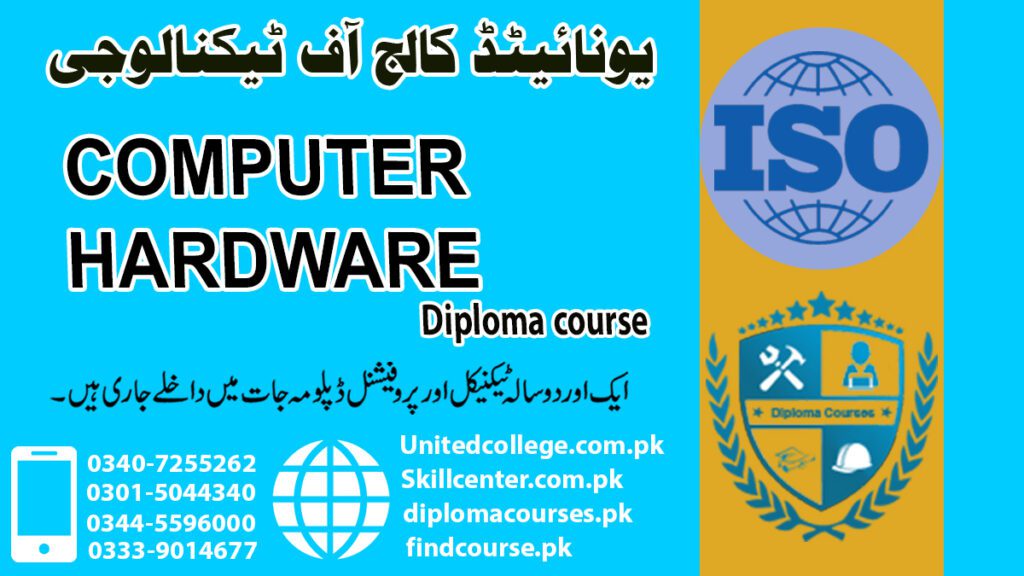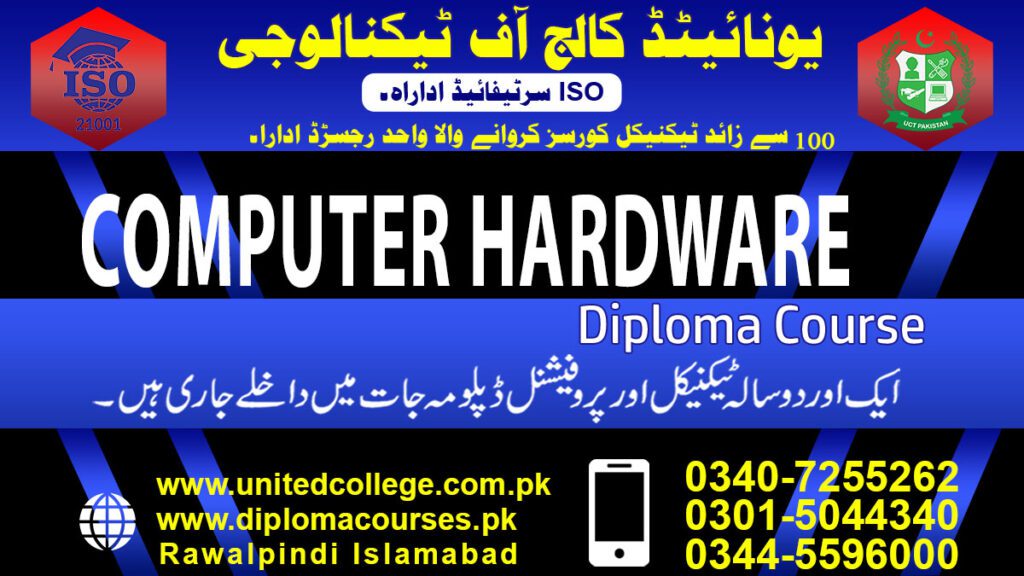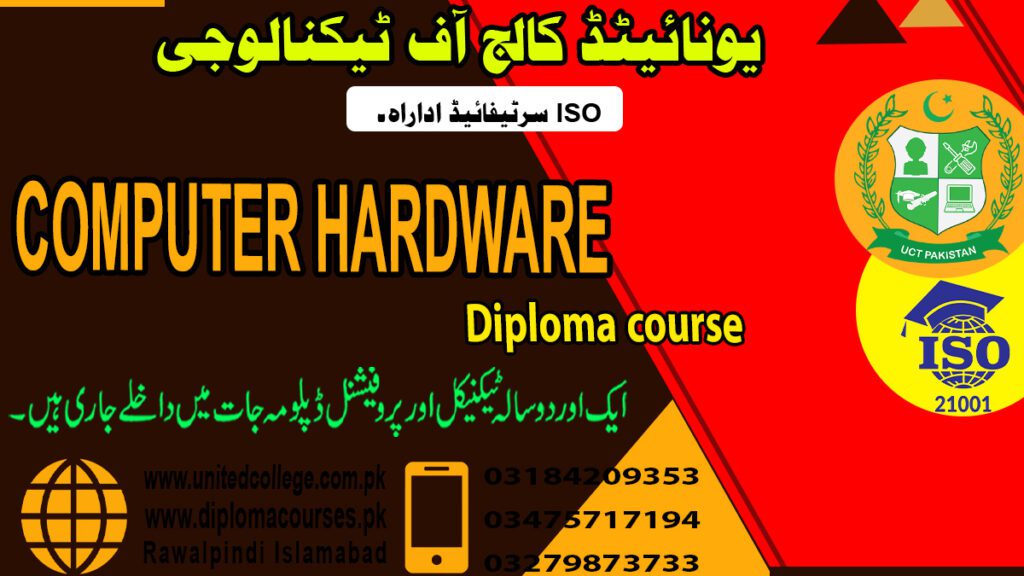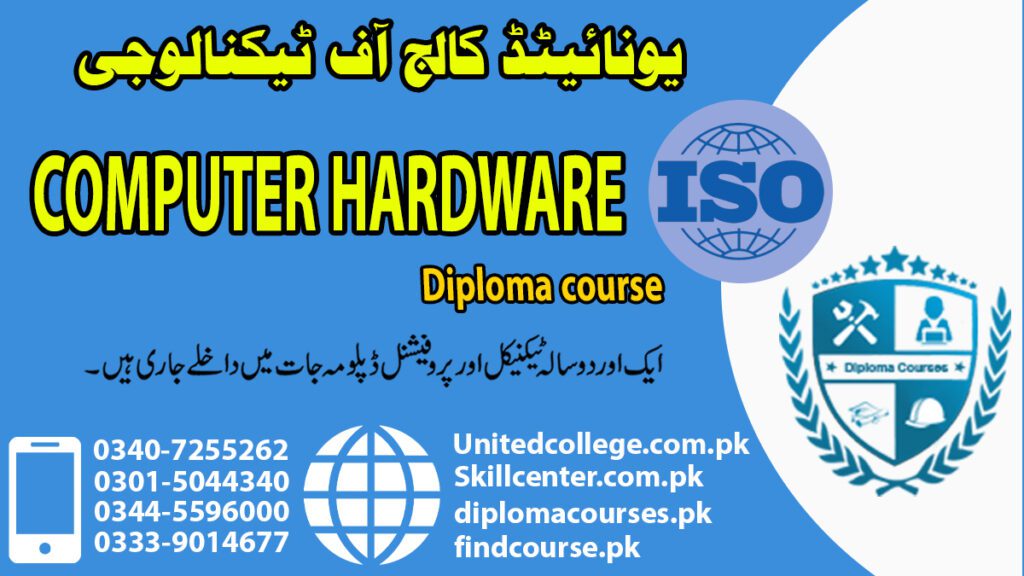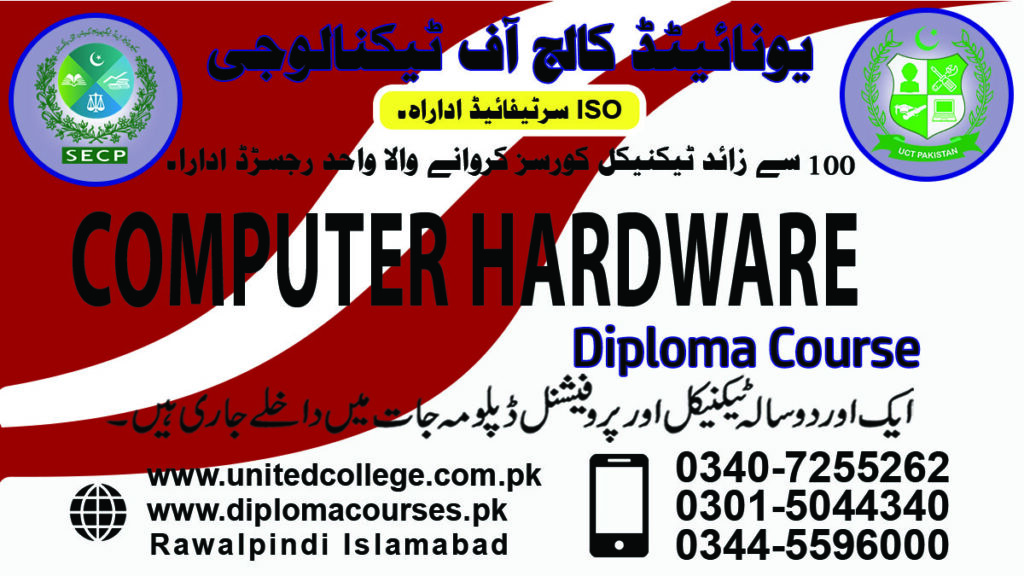COMPUTER HARDWARE COURSE IN RAWALPINDI ISLAMABAD PAKISTAN

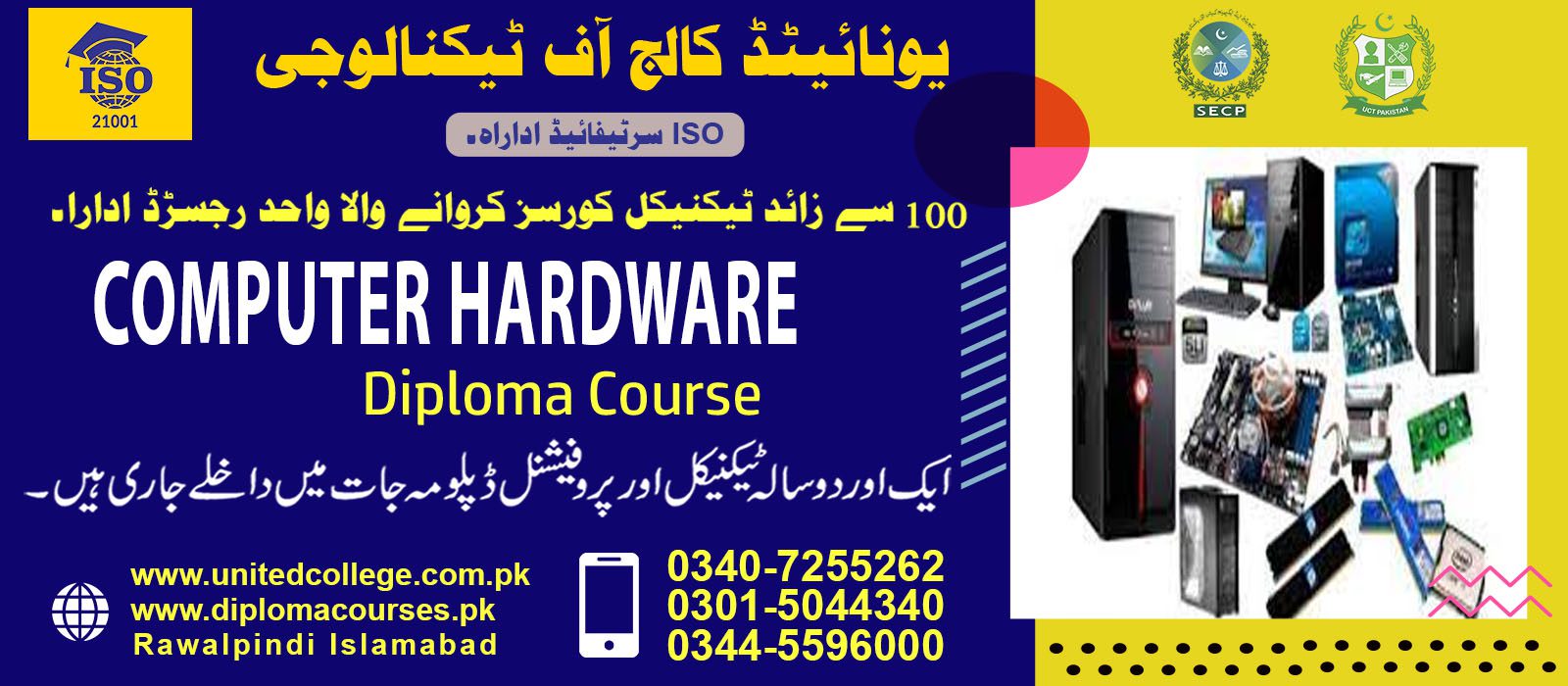
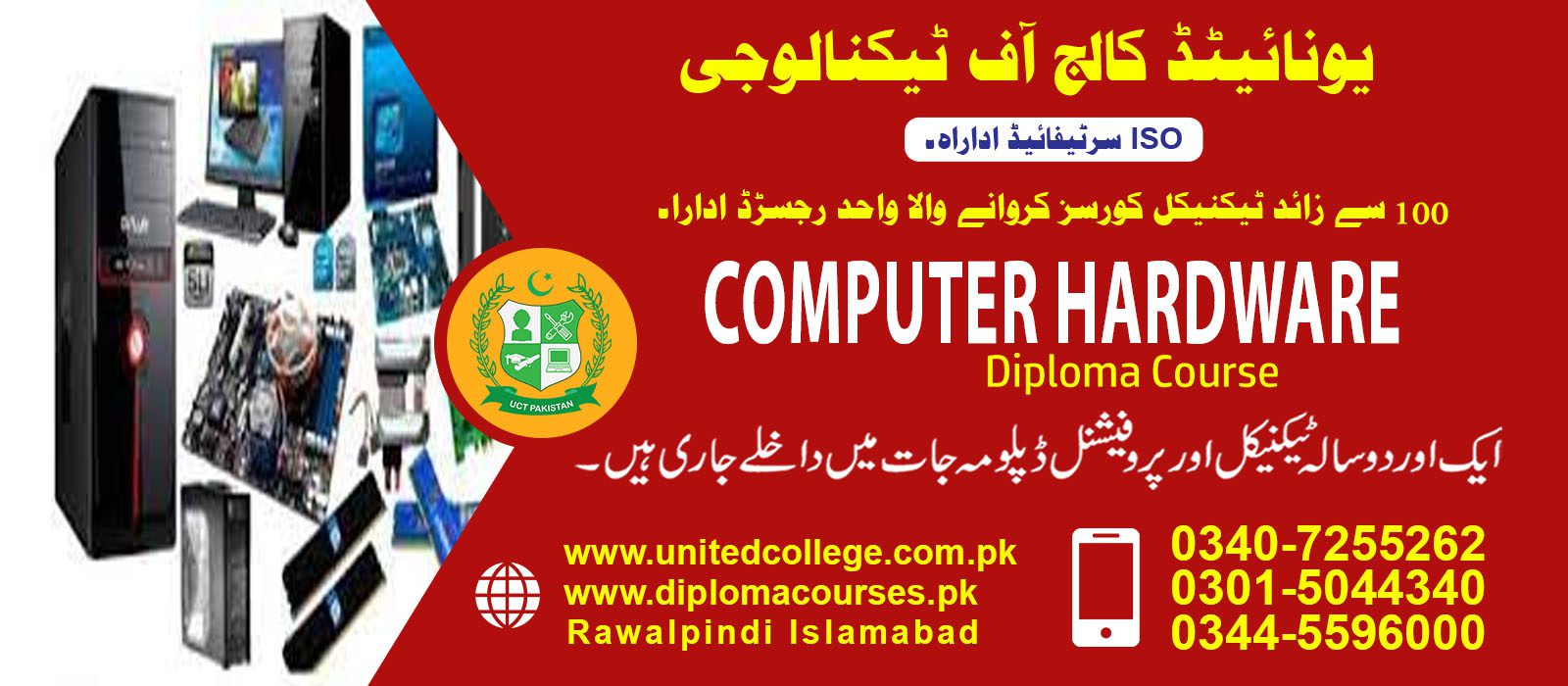

Computer Hardware Course in Rawalpindi Islamabad Pakistan 0344-5596000
Introduction:
The physical parts and gadgets that make up a computer system are referred to as computer hardware. It includes all the visible and touchable physical components of a computer. Computer hardware is responsible for processing, storing, and transmitting data and includes various components such as:
- Central Processing Unit (CPU): Often referred to as the “brain” of the computer, the CPU is in charge of carrying out computations and executing commands.
- Memory (RAM): Random Access Memory (RAM) stores data that is currently being used by the computer. It provides temporary storage for programs and data while the computer is running.
- Storage Devices: These devices are used to store data, files, and programs permanently. Examples include hard disk drives (HDDs), solid-state drives (SSDs), and optical drives (CD/DVD drives).
- Motherboard: The motherboard is the computer’s primary circuit board. It houses the CPU, RAM, and other essential components and provides connections for them to communicate with each other.
- Graphics Processing Unit (GPU): The GPU is responsible for rendering images, videos, and graphics. It is particularly important for tasks such as gaming, video editing, and graphic design.
- Input Devices: Input devices are used to provide data and commands to the computer. Examples include keyboards, mice, touchscreens, and scanners.
- Output Devices: Output devices display or present information from the computer. Examples include monitors, printers, speakers, and projectors.
- Expansion Cards: These are additional circuit boards that can be inserted into the motherboard to provide extra functionality, such as graphics cards, sound cards, and network interface cards.
- Power Supply Unit (PSU): The PSU converts electrical power from an outlet into the appropriate voltage and supplies it to the various components of the computer.
- Cables and Connectors: Various cables and connectors are used to connect different components of the computer, such as SATA cables for connecting storage devices or HDMI cables for connecting displays.
- Cooling Systems: Cooling systems, such as fans or liquid cooling solutions, are used to prevent overheating and maintain optimal operating temperatures for computer components.
Computer hardware components work together to enable the execution of software applications and the processing of data. The combination and configuration of these hardware components determine the capabilities and performance of a computer system.
It’s important to note that computer hardware is distinct from software, which refers to the programs, applications, and operating systems that run on the hardware. Both hardware and software are essential for a computer system to function effectively.
Computer Hardware Course Outline:
- Introduction to Computer Hardware:
- Overview of computer hardware components and their functions
- Understanding the role of hardware in a computer system
- Differentiating between hardware and software
- Central Processing Unit (CPU):
- Understanding CPU architecture and operation
- Types of CPUs and their specifications
- CPU cooling and overclocking considerations
- Memory:
- Types of memory (RAM, ROM, cache)
- Memory modules and their installation
- Memory management and optimization
- Storage Devices:
- Understanding storage capacities, interfaces, and performance
- Disk partitioning and formatting
- Motherboard:
- Functions and components of the motherboard
- Expansion slots and connectors
- BIOS/UEFI configuration and firmware updates
- Graphics Processing Unit (GPU):
- Introduction to GPUs and their role in graphics rendering
- GPU architecture, types, and specifications
- Graphics card installation and driver management
- Power Supply Unit (PSU) and Cooling Systems:
- Understanding PSU types, power ratings, and efficiency
- Power management and safety considerations
- Input and Output Devices:
- Keyboards, mice, and other input devices
- Monitors, printers, and other output devices
- Connecting and configuring input/output devices
- Expansion Cards and Interfaces:
- Types of expansion cards (graphics cards, sound cards, network cards)
- Expansion slots (PCI, PCIe) and their compatibility
- USB, HDMI, DisplayPort, and other interfaces
- Troubleshooting Hardware Issues:
- Identifying common hardware problems and error codes
- Diagnosing and resolving hardware conflicts
- Hardware diagnostic tools and techniques
- Hardware Upgrades and Maintenance:
- Upgrading memory, storage, and other components
- Preventive maintenance and cleaning
- Handling and disposal of computer hardware
- Building a Computer:
- Step-by-step guide to assembling a computer
- Compatibility considerations for hardware components
- BIOS/UEFI setup and initial system configuration
Course Fee: 30,000
Daily Class: 2 Hours
Course Duration: Two Months
Morning / Evening
Call For Registration: 0344-5596000 / 0333-9014677 / 0340-7255262
Computer Hardware Course in Rawalpindi Islamabad Pakistan 0344-5596000
Computer Hardware Course in Rawalpindi Islamabad Pakistan 0344-5596000
Computer Hardware Course in Rawalpindi Islamabad Pakistan 0344-5596000
Computer Hardware Course in Rawalpindi Islamabad Pakistan 0344-5596000
Computer Hardware Course in Rawalpindi Islamabad Pakistan 0344-5596000
Computer Hardware Course in Rawalpindi Islamabad Pakistan 0344-5596000

